Moira Butterfield's Blog, page 5
August 21, 2023
Does writing make you sick? Moira Butterfield
Full-time writing seems like a safe enough physical job, right? Well, yes, but let’s check a few things about our working situation. I’d like to hear any thoughts or solutions that you may be trying to ensure your own workaday health.
Sitting for hours
Any job that involves sitting at a screen for hours isn’t that safe. We risk weight gain and lack of fitness creeping upon us. Apparently it generally slows the metabolism. In fact, looking this up online I’ve rather scared myself!
I am guilty of not addressing this. I did buy a fitness watch that buzzed and told me to move every half an hour. I found it really irritating and haven’t worn it for ages! I also fail to take lunch breaks – when I could be doing a quick walk. I’m attempting to build in a lunch break, without much success, I have to admit, as I keep forgetting to stop.
So what’s the answer? Does anyone have any good tips on moving around regularly when you are busy working?
Repetitive strain injury
This is a painful thing, when continual typing causes the arm to become inflamed – with pain in the wrist and sometimes right up to the shoulder. I can give you a tip here – Get a wrist support for your desk. I used to have a long bar-shaped one and I have one built into my mouse mat. I find it has solved things for me but you might need to experiment to get the one you like best.
Back pain
This is down to your typing chair, and the wrong one can have a big effect. You need to experiment to get the best one for you. I have an Ikea gaming chair with a small long cushion right at the base of my back, to support it. I find the cushion gives me good upright posture. A gaming chair is designed for computer gamers who spend long hours at the screen, so they are ergonomically good for writers, too.
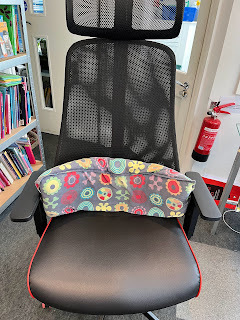 My Ikea gaming chair with back cushion
My Ikea gaming chair with back cushion
Headaches
This may sound weird but the angle you look at your screen can give you headaches. I have found that adjusting my monitor height and angle helps here, so I’m not straining my neck muscles. I have my laptop raised on a box and my big monitor raised on a stand. Experimenting with this is worth trying as one possibility to improve headaches.
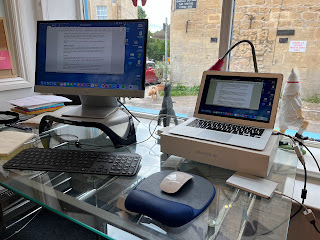 My work set-up, with raised screens and a wrist support mat
My work set-up, with raised screens and a wrist support mat
Mental health
Working on your own is weird. It’s isolating. Trying to make a living from writing is weird, too. It comes with a lot of mental challenges – from self-confidence failure to imposter syndrome, from self-destructive jealousy of other writers to problems with publishers, disappointment and dashed hopes…It takes a lot of strength to get through it sometimes.
I was given a good tip on why it’s worth spending time addressing your own mental health. People in other professions get plenty of career progression training, so think of yourself as your own employer. Give yourself that training. Mix with other sympathetic writers in a safe supportive arena where you can discuss feelings. Maybe even arrange some counselling for yourself. Here are two UK links to explore.
https://www.wellbeinginthearts.org.uk/#
https://dreamauthorcoaching.com
PS: I also have a 'pinboard of positivity' by my work station. I pin on images/messages to help me stay upbeat. I have neglected it recently so I'm now revamping! It's only a small thing but it's there to help my state of mind.
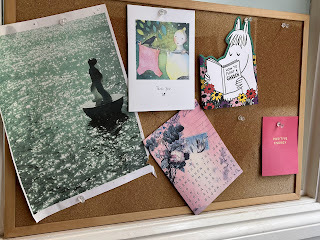 My pinboard of positivity - going through a revamp.
My pinboard of positivity - going through a revamp.
Please do add your own writing health tips below.
Stay well, and happy writing!
Moira Butterfield
twitter @moiraworld
instagram @moirabutterfieldauthor
threads @moirabutterfieldauthor
August 13, 2023
THE FIRST ANNIVERSARY OF 'BOOKS THAT HELP' - by Clare Helen Welsh
Some of you may know that this time last year, I set about championing outstanding picture books that help when times are hard; the books that are much more than just words and pictures on a page... the ones that stay with you long after the last page has turned and lead to further thoughts, experiences, discussions. The ones that help when the words are hard to find.

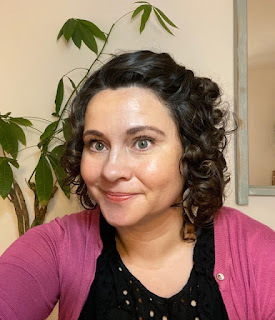
BOOK REVIEWS:
In a year, I've managed to review 231 Books That Help across 27 categories including family separation and divorce, loss, anxiety and bedtimes. You can find all the reviews here! I haven't done it alone - there have been guest reviewers, including Kara Kiernan from The Book Train, Catherine Friess from Story Snug, Sophia Payne, Catherine Ward, Laura Baker, Emily Davison, Naomi Jones, Sarah Tagholm and Ian Eagleton.
BOOKSHOPS:
Each month, there's been support for a different independent bookshops, including Snug Bookshop, Write Blend, Reading Rocks, The Ivybridge Bookshop, East Gate Bookshop, The Bookery , Wonderland Bookshop, Bookstop St Helens, Books On The Hill, Harbour Bookshop, Kibworth Bookshop, Bookworm Dubai and Quinns Bookshop with more bookshops to champion on the horizon!
AUTHORS:
For those wanting to write Books That Help, there was a mentorship with myself and Ellie Farmer and Perry Emerson from Little Tiger Press. The 2022 winner was Lucy Falkner with her text Dung Beetle Doug. You can expect an update on 2023's mentorship soon. In the meantime, you can read more about last year's mentorship here. This is what Lucy had to say about her experience:
What an opportunity the Books That Help mentorship has been! I have learnt a huge amount about the craft of picture book writing over the last six months and my stories have benefited enormously from Clare's tailored teaching and detailed critiques. To be guided by someone with such brilliant knowledge of the picture book market has been very helpful and I am now in a position to send my first submission package, something that felt a long way off at the beginning of this mentorship!
I am also hugely grateful to have had such helpful feedback on my writing from Perry Emerson at Little Tiger, who has been very generous with his time. I am sad that the mentorship has come to an end but am delighted with the progress I have made under Clare's expert guidance and feel prepared for my next steps.
Thank you to Clare and Little Tiger for a wonderful experience!
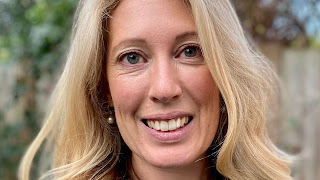
LUCY FALKNER - 'Books That Help mentee 2022'
SCHOOLS:
To help spread the word about Books That Help in schools, I've been working with The Grove Primary School, Totnes, to bring well-being libraries into the school community. When the project is finished, we're hoping to make all our resources downloadable for schools to recreate the project. They'll be posted here when the time comes!
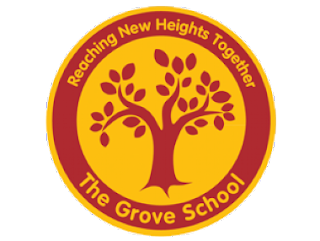
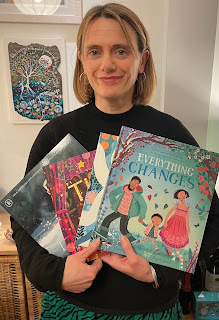
VIKKI DREW, teacher at The Grove Primary School
Phew! As you can see, it's been quite a year! And I've been so lucky to have the support of lots of lovely booklovers. In fact, some of them gave quotes about why they feel books are so important in today's world. There's a collection of them recorded in a first anniversary film, and others have been compiled into a PDF that can be printed and downloaded for posters and displays. I'll leave a few of them below too :-)
There's lots more planned for Books That Help's second year, but for now, what are your favourite Books That Help and why? Please feel free to share them in the comments below.


















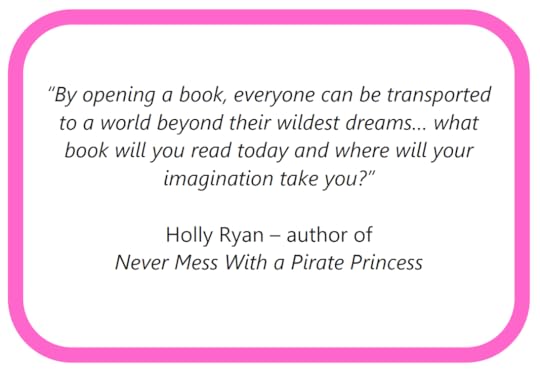












CLARE HELEN WELSH
Clare Helen Welsh is a children's writer from Devon. She writes fiction and non-fiction picture book texts - sometimes funny, sometimes lyrical and everything in between! Her latest picture book is called 'Never, Ever, Ever Ask A Pirate To A Party,' illustrated by Anne-Kathrin Behl and published by Nosy Crow. You can find out more about her at her website www.clarehelenwelsh.com or on Twitter @ClareHelenWelsh . Clare is represented by Alice Williams at Alice Williams Literary.
July 30, 2023
Accidental Route into Making Picture Books by Nadia Shireen
Nadia Shireen is an award-winning author and illustrator of picture books and chapter books. We asked Nadia about how she started out and her advice for those who are starting out now. Enjoy!
My route into becoming a picture book maker was offbeat and almost accidental. After a few years of working in magazine publishing, I started to take evening classes in illustration. This was mainly because I was constantly doodling over the sheets of paper I was supposed to be editing (distracting for all concerned.)Anyway, these evening classes led to me eventually undertaking a part time MA in children’s book illustration at Anglia Ruskin University in 2008. I was, to be blunt, a bit of an oddball on the course. Trying to juggle a career as a freelance journalist with no formal art training meant that I found it a bit of a struggle, and I got heroically behind with the coursework. A career in picture books wasn’t something I was even contemplating at this point.
But the course was invaluable in so many ways. For a start, thanks to the tutelage of experts and practitioners (such as Martin Salisbury, John Lawrence, Pam Smy and James Mayhew) I learnt to love picture books and appreciate how word and image can collide to create magic.
However, there were also the dreaded regular group crits, when everyone would take it in turn to nervously share their works-in-progress to the rest of the group. You could expect to:
1) Receive tentative feedback from friendly peers
2) Receive constructive feedback from informed tutors
3) Try not to cry
And someone would always, always cry. The many caring, generous and encouraging compliments seemed to bounce off the surface of our brains like hail on a tin roof. The criticisms? Now those guys would burrow into our souls, destined to stay there forever.
To make things even more complicated, the next month we would maybe get a different kind of constructive feedback from a different tutor, which sometimes totally contradict the previous critique. This cause a bit of a tailspin. Whose feedback should you believe? Whose opinion could you trust?
Though it didn’t feel like it at the time, we were learning an invaluable lesson. As a picture book maker, you soon realise that the best projects are a collaborative effort. With a bit of luck, the team you are working with share the same end goal – to make the best book possible. I work closely with fantastic editors and art directors, who add immense value to every book I make.
This means that you need to learn to park your ego at the door and take critique on board. It also means you need to develop and trust your own judgement. Because inevitably down the line, people will not agree. There may be a difference of opinion over a sentence, or a page layout, or the colour of a bear’s nose.
Now, to further expose myself as a bit of a twerp, my knee-jerk reaction to any proposed editorial or art change might be “No way! These are MY perfect words and MY beautiful pictures and nobody else is going to change them! So there.”
This is not a helpful reaction.
A wiser reaction might be to ask oneself why does something need to change… and is this particular solution the best one? If you’re able to really easily articulate exactly why something needs to be the way it is, then you’re probably right. It’s all about being able to explain the reasons behind that gut instinct.

Yes this can sometimes be tricky, but it is a skill that can be developed and honed. And really, it’s about learning to cut through the noise of many opinions and trust your own judgement.
If, on the other hand, you can’t really drum up much of a reason as to why a particular sentence/drawing/bear nose cannot be changed, it may be a sign that you need to loosen your grip and allow things to evolve with the guidance of smart people who want to help.
I’ve definitely felt sad about losing drawings or plot beats that I was really attached to. But pretty much every time I have done so, taking on board someone else’s feedback has resulted in a much better book.
Everyone’s experience of making a picture book is different, of course. But in mine, any success I have had is shared with the editors and art directors I have collaborated with.

So my advice would be to try not to be scared or discouraged by thoughtful critique. Instead try to embrace it, gently grapple with it where necessary, and high-five your ego for waiting politely outside.
 Nadia Shireen is a picture book author and illustrator. Her books include Good Little Wolf, The Bumblebear, Billy and the Beast, Barbara Throws a Wobbler and most recently, Geoffrey Gets the Jitters.
Nadia Shireen is a picture book author and illustrator. Her books include Good Little Wolf, The Bumblebear, Billy and the Beast, Barbara Throws a Wobbler and most recently, Geoffrey Gets the Jitters. She also writes and illustrates the Grimwood series for older children.
Find out more at https://www.nadiashireen.org/ and follow her on Twitter (or X as some people call it now) and Instagram here.
July 16, 2023
Top Tips for New Picture Book Writers - Lynne Garner and Friends
I'd planned to write a post where I shared my top tips for those new to picture book writing. I'd written my first paragraph when I decided to include some helpful links from the Picture Book Den. However, it soon became clear I would be repeating advice already given and perhaps not as eloquently as other members of the PBD team or our guests. So, I decided to pick a few posts which I hope new picture book writers will find helpful.
So in no particular order
Writing Retreat - Abie Longstaff (includes advice on how to shape your story)
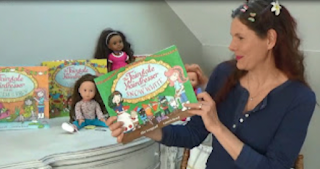 Abie Longstaff - www.abielongstaff.com/
Abie Longstaff - www.abielongstaff.com/An Acrostic of Patience - Chitra Soundar
 Chitra Soundar - http://www.chitrasoundar.com/
Chitra Soundar - http://www.chitrasoundar.com/How Not To Write a Rhyming Picture Book - Juliet Clare Bell
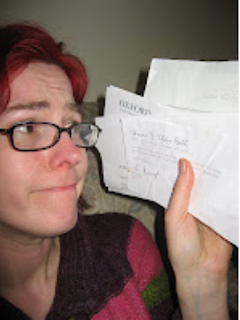 Juliet Clare Bell - www.julietclarebell.com
Juliet Clare Bell - www.julietclarebell.comChecking Roughs - a Vital Picture Book Author Skill - Moira Butterfield
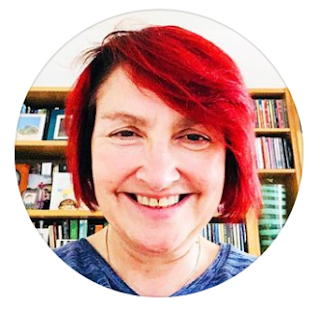 Moira Butterfield - www.moirabutterfield.co.uk
Moira Butterfield - www.moirabutterfield.co.ukWriting (Picture Books) As a Business - Natascha Biebow
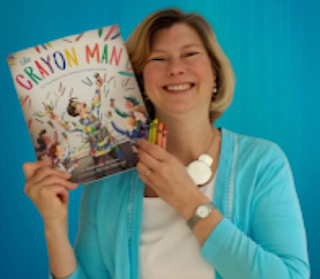 Natascha Biebow - www.nataschabiebow.co
Natascha Biebow - www.nataschabiebow.coDo You Control The Verse, or Does The Verse Control You? Michelle Robinson
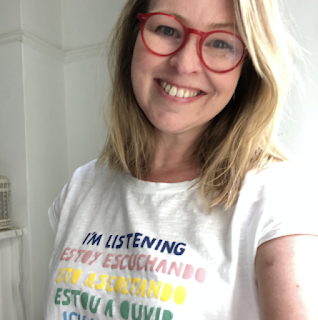 Michelle Robinson - www.michellerobinson.co.uk
Michelle Robinson - www.michellerobinson.co.ukSuccessful Query Letters and Routes to Publication - Clare Helen Welsh and Friends
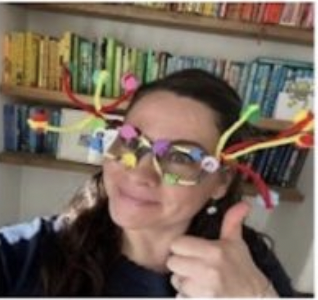 Clare Helen Welsh - https://clarehelenwelsh.com/
Clare Helen Welsh - https://clarehelenwelsh.com/And lastly here's my top tips from a past I'd forgotten I'd written.
Ten Top Picture Book Writing Tips
 Lynne Garner - https://lynnegarner.com/
Lynne Garner - https://lynnegarner.com/I hope you find these useful and if you have any tips yourself please do share.
July 9, 2023
How to Trust and Allow Space for the Picture Book Illustrator • by Natascha Biebow
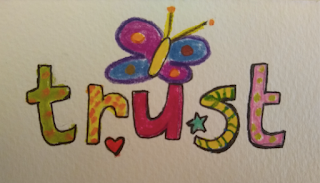
As apicture book writer, I often wish I had the talent of those author/ illustratorswho can write and illustrate. Theyhave a superpower in that they can mix and match the words and pictures, addinglayers and making choices to balance out the story so it is just right.
But, ifyou’re ‘just’ a writer, you have to allow space for the illustrator and thensit back and wait for the layouts to unfold into a fully-formed picture bookthat is just right. It’s an exercise in trust and letting go. The results areoften hugely gratifying, but it can be a scary process.
Will theillustrator capture the author’s vision?
What ifthey miss a key element or get it ‘wrong’?
Thetemptation can be to want to take control and to over-write or art-direct withillustration notes.
Intraditional publishing, authors work with a skilled team – a designer and aneditor, and sometimes also the publisher and art director – who are incrediblyexperienced and knowledgeable in the art of making picture books. They help topull together all the elements to create a seamless picture book that will captivateyoung readers. A lot of time, careful thought and revision goes into thisprocess, including choosing the right illustrator for each story.
What’sinteresting is that often illustrators add whole new storylines in the pictures– Pippa Goodhart recently blogged about this in her ‘The Joy of VisualSub-Plots’ post. These sub-plots are filled with lots of fabulous details tospot and mini-storylines to follow, making the book one to which young readerswill return to again and again.
Somethingelse spectacular often happens, though, when authors let go of their words andcreate space for illustrators:

Layersand depth!
Thelayers are created when illustrators springboard off the text to imagine the storyon the page – the key plot turning points, the setting and the characters, completewith individual personalities. Illustrators deepen the themes by attributing tothem a visual representation, making them accessible and relevant to youngreaders, who are often astute visual thinkers.
InterpretingThemes:
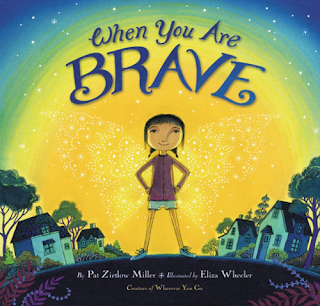 When You Are Brave by Pat Zietlow Miller and Eliza Wheeler
When You Are Brave by Pat Zietlow Miller and Eliza Wheeler
WHEN YOUARE BRAVE: Pat Zietlow Miller and Eliza Wheeler is the story of being bravewhen you have to do things in life that you’re much rather not do. The author’swords for the opening:
“Some days, when everything around you seemsscary,
you have to be brave.
“Brave as a bird that steps from its nest .. .
hoping to soar through the sky.
“Brave as a dog that wanders for miles . . .
searching for a well-known light.
“Brave as a caterpillar that builds a bed .. .
wondering where it will wake.
Because some days are full of things you’drather not do.”
These phrases could have been illustrated in so many different ways. ElizaWheeler depicts the situation as a girl’s family moving home
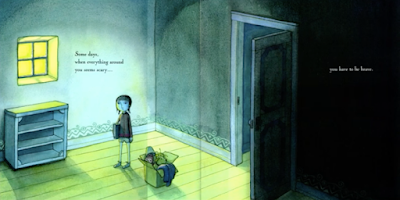 From When You Are Brave by Pat Zietlow Miller and Eliza Wheeler
From When You Are Brave by Pat Zietlow Miller and Eliza Wheeler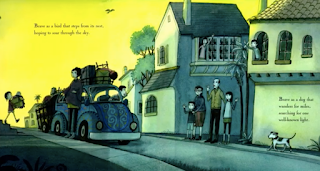 From When You Are Brave by Pat Zietlow Miller and Eliza Wheeler
From When You Are Brave by Pat Zietlow Miller and Eliza Wheeler
and creates aneat segue between the metaphorical, lyrical words by illustrating a physicalbird, dog, and caterpillar as the girl’s precious stuffed toys. Thus, Eliza helpsto make the abstract more concrete and relatable for young readers.
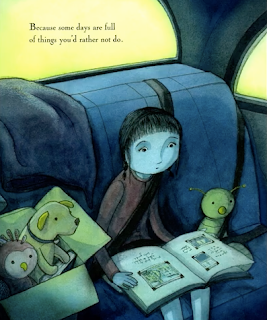 From When You Are Brave by Pat Zietlow Miller and Eliza Wheeler
From When You Are Brave by Pat Zietlow Miller and Eliza Wheeler
In THETRUTH ACCORDING TO ARTHUR by Tim Hopgood, David Tazzyman must depict what a completelyabstract character (The Truth) looks like and give it a personality.
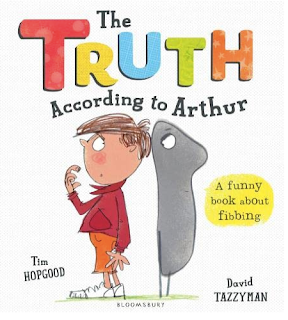 The Truth According to Arthur by Tim Hopgood and David Tazzyman.
The Truth According to Arthur by Tim Hopgood and David Tazzyman.
He deftly imaginesthe situations in which the boy bends, stretches, ignores and covers up The Truth.
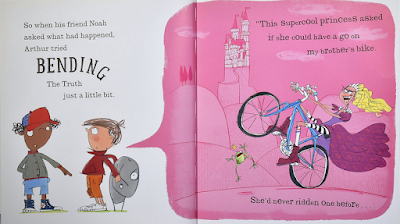 The Truth According to Arthur by Tim Hopgood and David Tazzyman.
The Truth According to Arthur by Tim Hopgood and David Tazzyman.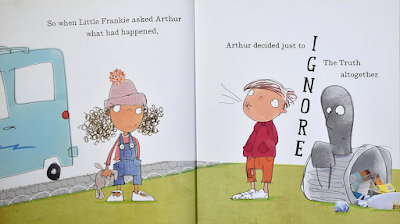 The Truth According to Arthur by Tim Hopgood and David Tazzyman.
The Truth According to Arthur by Tim Hopgood and David Tazzyman.
In I AMNEFERTITI by Annemarie Anang, Natelle Quek also artfully captures an abstractelement – music.
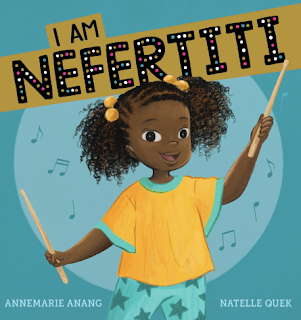 I Am Nefertiti by Annemarie Anang and Natelle Quek
I Am Nefertiti by Annemarie Anang and Natelle Quek
Natelle shows how the band feels and sounds when it makes musicthat is discordant and harmonious, even adding different colours for eachinstrument.
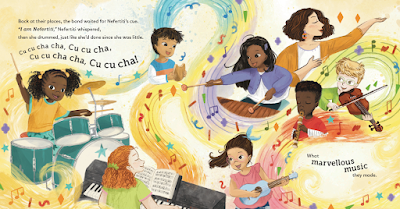 From I Am Nefertiti by Annemarie Anang and Natelle Quek
From I Am Nefertiti by Annemarie Anang and Natelle Quek
The main character, Nefertiti,is the drummer, who keeps the all-important beat in the band. But when her teacher shortens her name to ‘Nef’ because it’s easier topronounce, something shrinks inside her – both literally and figuratively. In orderto make this idea accessible to young readers, Natelle needed to showNefertiti’s physical transformation as well as how it felt. To convey this, shepositioned the main character tiny amongst the looming drums:
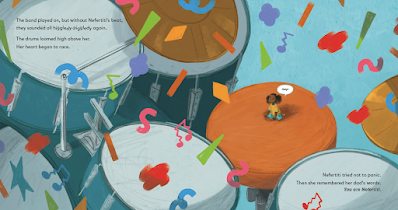 From I Am Nefertiti by Annemarie Anang and Natelle Quek
From I Am Nefertiti by Annemarie Anang and Natelle Quek
Characters& Their Worlds :
I AM NEFERTITI is a story about identity and belonging; the multicultural,diverse cast of band members is intrinsic to the narrative. Working from thestarting point of the author’s text (just the characters' names and their instruments),the illustrator and editorial and design team worked closely together toenvision what each child should look like:
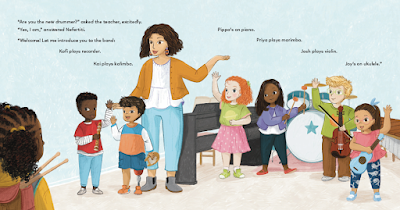 From I Am Nefertiti by Annemarie Anang and Natelle Quek
From I Am Nefertiti by Annemarie Anang and Natelle Quek
In JamesCatchpole’s WHAT HAPPENED TO YOU?, Karen George also creates an authentic groupof children, and sets them in the playground, cleverly juxtaposing the realwith the imaginary using blocks of solid colour.
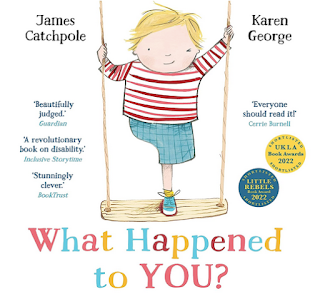 What Happened to You? by James Catchpole and Karen George
What Happened to You? by James Catchpole and Karen George
The maincharacter, Joe, says, “And there are sharks down here, too.
Theyespecially like to eat pirates.”
If youlook closely at this scene, Karen George adds all the drama of differentchildren’s reactions to the pretend play in their well-observed expressionsand body language. This is intuited in the dialogue between Joe and the curiouschildren, but not written explicitly into the text. It is more powerful thisway.
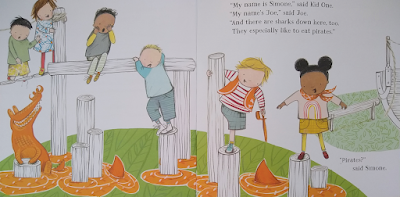 From What Happened to You? by James Catchpole and Karen George
From What Happened to You? by James Catchpole and Karen George
In LASTSTOP ON MARKET STREET by Matt de la Peña and Christian Robinson, a boy sets out on a bus journey withhis grandma.
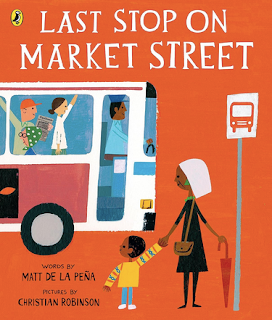 Last Stop on Market Street by Matt de la Peña and Christian Robinson
Last Stop on Market Street by Matt de la Peña and Christian Robinson
Readers are introduced to the people they meet, among them, a blind man andguide dog, a musician, and a woman with butterflies in a jar. The illustratorhas to decide: what kind of dog? What ages, ethnicities and backgrounds will thepeople be? What should they wear? How will young readers engage with thepictures. Will they see themselves and their backgrounds represented? And somuch more!
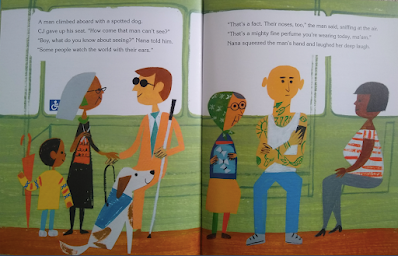 Last Stop on Market Street by Matt de la Peña and Christian Robinson
Last Stop on Market Street by Matt de la Peña and Christian Robinson
Similarly,in MY DADDIES! by Gareth Peter, the illustrator, Garry Parsons, imagines whatthis family looks like and how they act and react in each scene.
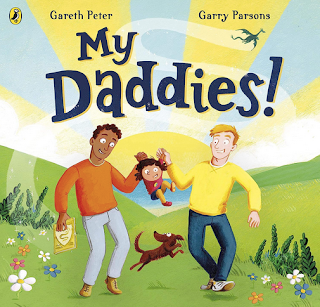 My Daddies! by Gareth Peter and Garry Parsons
My Daddies! by Gareth Peter and Garry Parsons
Theillustrator must imagine situations to best convey the layers and flesh out theaccompanying words. For instance:
“They’renot the best at everything . . .
(one dad is not a particularly good artist)
but Idon’t really care.”
(one dad is not a particularly good cook)
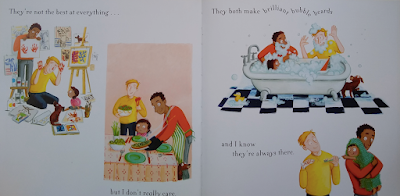 From My Daddies! by Gareth Peter and Garry Parsons
From My Daddies! by Gareth Peter and Garry Parsons
It’salmost as if the words are ‘coming true’.
Especiallypoignant, is the double-paged spread, where the child’s adoption story islovingly imagined and portrayed from babyhood to new, two-dad family home.
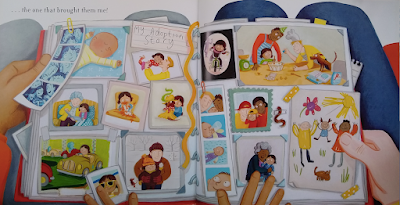 From My Daddies! by Gareth Peter and Garry Parsons
From My Daddies! by Gareth Peter and Garry Parsons
Theillustrator is essentially adding a 3-D version of the author’s words,envisioning the child’s adoption journey and the family’s home life, and makingit feel real and relatable to every young reader.
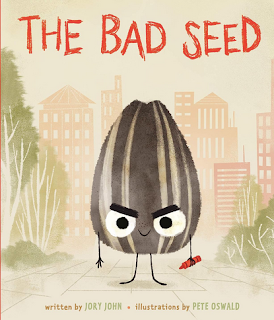 The Bad Seed by Jory John and Pete Oswald
The Bad Seed by Jory John and Pete OswaldIn THEBAD SEED by Jory John, Pete Oswald envisions what a ‘bad’ seed might look like:
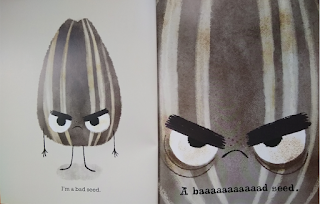 From The Bad Seed by Jory John and Pete Oswald
From The Bad Seed by Jory John and Pete Oswald
And what the seed might do when lying:
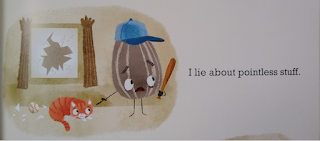 From The Bad Seed by Jory John and Pete Oswald
From The Bad Seed by Jory John and Pete Oswald
Or inwhich situation the seed might cut in line:
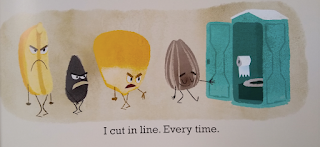 From The Bad Seed by Jory John and Pete Oswald
From The Bad Seed by Jory John and Pete Oswald And whatother bad things the seed might do:
 From The Bad Seed by Jory John and Pete Oswald
From The Bad Seed by Jory John and Pete Oswald
And what the seed might do when turned nice:
 From The Bad Seed by Jory John and Pete Oswald
From The Bad Seed by Jory John and Pete Oswald
Inessence, Pete Oswald has envisioned the ‘bad’ seed’s entire world and background, and madeimportant choices about how to convey the emotional journey of the maincharacter as readers turn the pages. This isn’t written into the author’s wordsper se, but as a finished picture book, it is so much richer with the illustrator’scontributions.
Finally,sometimes, the layers and depth of the message emerge in the form of a visualpunchline, such as in SUSAN LAUGHS by Jeanne Willis and Tony Ross.
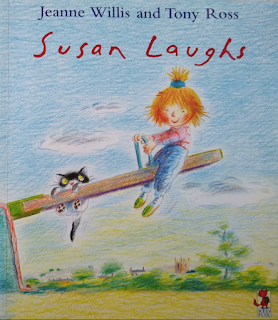 Susan Laughs by Jeanne Willis and Tony Ross
Susan Laughs by Jeanne Willis and Tony Ross
In thisbook, the space evoked by the words is filled with the pictures of Susanenjoying life just as any able-bodied child might. The detail in the pictures adds context about Susan's family, friends, and the activities she enjoys - for example "Susan flies" could have been interpreted in many different ways!
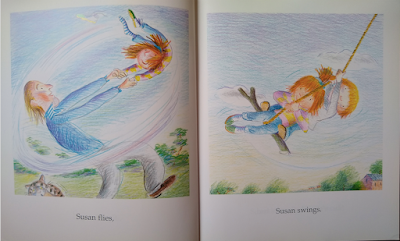 From Susan Laughs by Jeanne Willis and Tony Ross
From Susan Laughs by Jeanne Willis and Tony Ross
The final page shows Susanis in her wheelchair, and together with the preceding images, a picture of thewhole suddenly emerges – Susan as a child just like every other.
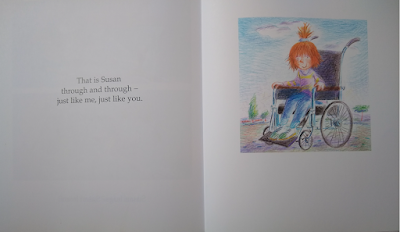 From Susan Laughs by Jeanne Willis and Tony Ross
From Susan Laughs by Jeanne Willis and Tony Ross
Nexttime, you’re tempted to be wordy, to add too much description, or even toover-art-direct a book, have faith. Think: could the illustrator add thoselayers? Time to trust!
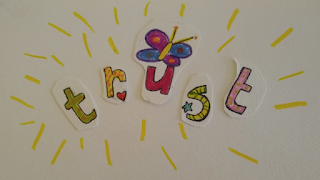
It’s totally worth it, and you’ll end up with a richerbook as a result.
_________________________________________________________________
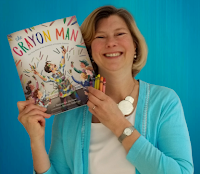 Natascha Biebow, MBE, Author, Editor, Coach and Mentor
Natascha Biebow, MBE, Author, Editor, Coach and MentorNatascha is the author of the award-winning The Crayon Man: The True Story of the Invention of Crayola Crayons, illustrated by Steven Salerno, winner of the Irma Black Award for Excellence in Children's Books, and selected as a best STEM Book 2020. Editor of numerous prize-winning books, she runs Blue Elephant Storyshaping, an editing, coaching and mentoring service aimed at empowering writers and illustrators to fine-tune their work pre-submission, and is the Editorial Director for Five Quills. Find out about her new picture book webinar courses! She is Co-Regional Advisor (Co-Chair) of SCBWI British Isles. Find her at www.nataschabiebow.com
@font-face {font-family:"MS 明朝"; mso-font-charset:78; mso-generic-font-family:auto; mso-font-pitch:variable; mso-font-signature:-536870145 1791491579 18 0 131231 0;}@font-face {font-family:"Cambria Math"; panose-1:2 4 5 3 5 4 6 3 2 4; mso-font-charset:0; mso-generic-font-family:auto; mso-font-pitch:variable; mso-font-signature:-536870145 1107305727 0 0 415 0;}@font-face {font-family:Calibri; panose-1:2 15 5 2 2 2 4 3 2 4; mso-font-charset:0; mso-generic-font-family:auto; mso-font-pitch:variable; mso-font-signature:-520092929 1073786111 9 0 415 0;}@font-face {font-family:"Arial Unicode MS"; panose-1:2 11 6 4 2 2 2 2 2 4; mso-font-charset:0; mso-generic-font-family:auto; mso-font-pitch:variable; mso-font-signature:-134238209 -371195905 63 0 4129279 0;}@font-face {font-family:"Helvetica Neue"; panose-1:2 0 5 3 0 0 0 2 0 4; mso-font-charset:0; mso-generic-font-family:auto; mso-font-pitch:variable; mso-font-signature:-452984065 1342208475 16 0 1 0;}@font-face {font-family:"Trebuchet MS"; panose-1:2 11 6 3 2 2 2 2 2 4; mso-font-charset:0; mso-generic-font-family:auto; mso-font-pitch:variable; mso-font-signature:647 0 0 0 159 0;}p.MsoNormal, li.MsoNormal, div.MsoNormal {mso-style-unhide:no; mso-style-qformat:yes; mso-style-parent:""; margin:0cm; margin-bottom:.0001pt; mso-pagination:widow-orphan; font-size:12.0pt; font-family:"Times New Roman"; mso-fareast-font-family:"MS 明朝"; mso-fareast-theme-font:minor-fareast; mso-ansi-language:EN-US;}a:link, span.MsoHyperlink {mso-style-priority:99; color:blue; mso-themecolor:hyperlink; text-decoration:underline; text-underline:single;}a:visited, span.MsoHyperlinkFollowed {mso-style-noshow:yes; mso-style-priority:99; color:purple; mso-themecolor:followedhyperlink; text-decoration:underline; text-underline:single;}p.Default, li.Default, div.Default {mso-style-name:Default; mso-style-unhide:no; mso-style-parent:""; margin-top:8.0pt; margin-right:0cm; margin-bottom:0cm; margin-left:0cm; margin-bottom:.0001pt; mso-pagination:widow-orphan; font-size:12.0pt; font-family:"Helvetica Neue"; mso-fareast-font-family:"Arial Unicode MS"; mso-bidi-font-family:"Arial Unicode MS"; color:black; border:none; mso-style-textoutline-type:none; mso-style-textoutline-outlinestyle-dpiwidth:1.0pt; mso-style-textoutline-outlinestyle-linecap:flat; mso-style-textoutline-outlinestyle-join:miter; mso-style-textoutline-outlinestyle-pctmiterlimit:400.0%; mso-style-textoutline-outlinestyle-dash:solid; mso-style-textoutline-outlinestyle-align:center; mso-style-textoutline-outlinestyle-compound:simple; mso-ansi-language:EN-US; text-underline:black;}.MsoChpDefault {mso-style-type:export-only; mso-default-props:yes; font-size:10.0pt; mso-ansi-font-size:10.0pt; mso-bidi-font-size:10.0pt; mso-fareast-font-family:"MS 明朝"; mso-fareast-theme-font:minor-fareast; mso-fareast-language:JA;}div.WordSection1 {page:WordSection1;}
July 2, 2023
The Magic of Pop-Up (or should that be Plop-Up?) with Mini Grey
 The book: it’s portablemagic – an object full of possibilities. With pop-up books there’s thepossibility that the book is a Tardis: bigger on the inside. A world explodesfrom the book. Pop-ups are about movement: the book comes to life in yourhands.
The book: it’s portablemagic – an object full of possibilities. With pop-up books there’s thepossibility that the book is a Tardis: bigger on the inside. A world explodesfrom the book. Pop-ups are about movement: the book comes to life in yourhands.Pop-ups are madepossible by the structure of the book, that central fold that lends itself tomovement and acts as the engine that moves the mechanism: opening and shuttingso that pop-ups can hide away inside.
So, this week(inspired by Garry’s post from April about lift-the-flap books) I thought I’dbring you a quick tour of the history of pop-up, through books I’ve picked upover the years.
The first pop-ups were for grown-ups, todo useful things like show the movements of the planets or the structure of thehuman body.
 De Humani Corporis Fabrica by Vesalius
De Humani Corporis Fabrica by VesaliusIn Andreas Vesalius’s book DeHumani Corporis Fabrica (Onthe Fabric of the Human Body) from 1543, layered pages allow the reader toprobe through the layers of the human body. Now I don’t have this book, but I have seen it! Theimages were woodblock printed, then cut out like fine lacework.
On my bookshelf westart with Lothar Meggendorfer and the first golden age of pop-ups in Victoriantimes. With industrialization, a wealthy middle class was emerging who hadincome to spend on books for children, and all could gather in the evenings tobe entertained by the movable book. Meggendorfer’s moving pictures had an amazinglycomplicated under-structure of tabs and metal pivots.
 Movable horserider by Meggendorfer
Movable horserider by Meggendorfer This is the kind of mechanism of levers and pivots that would have lain beneath the movable piccture.
This is the kind of mechanism of levers and pivots that would have lain beneath the movable piccture.International Circus (by Meggendorfer) isa book that is also a toy and a model.
 My copy of International Circus opened out, each scene pulls down with a parallel box type mechanism.
My copy of International Circus opened out, each scene pulls down with a parallel box type mechanism.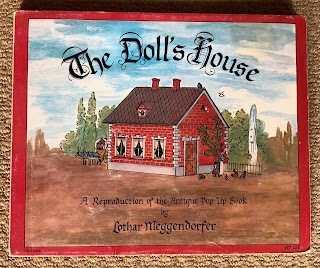
Meggendorfer’s Doll’s House folds outinto a set of rooms you could play with.

That golden age of pop-up wasbrought to a close by the 20th century and the first worldwar: materials for making books became scarce. Then in the late 1920s theDaily Express started publishing the Bookano books.

These were fat volumes withself-erecting pop-up ‘models’. They were made of cheap low-quality paper whichmeant they were affordable, so pop-ups were suddenly available to a massmarket. One Bookano was given to me by John Vernon Lord. It had been given tohim by Raymond Briggs.

It must have been well played with; every single pop-upis broken except one.
 The one unbroken pop-up in Briggs' Christmas present
The one unbroken pop-up in Briggs' Christmas presentBut not broken is the Bookano Story of Jesus – somehow this onestayed safe from young fingers.
Look at this – the last supper, assembled in a panelled room. Judas is skulking off in the background. There's a landscape beyond the back window. Da Vinci would have beenproud.
 In case you're wondering , there are 12 disciples in this pop-up but two of them are at right angles to us so we can only see their Flat Stanley-style edges.
In case you're wondering , there are 12 disciples in this pop-up but two of them are at right angles to us so we can only see their Flat Stanley-style edges.In my Bookano Stories book is a fabulous underwater world complete withcellophane water layer.

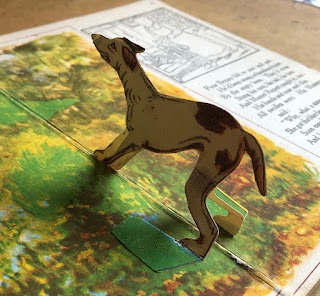
The stand-up models in the Bookano books, like thisdog, remind me of The Tiger Prowls by Seb Braun; there’s something lovely about 3D animalsspringing up on the page.

In Prague I cameacross the work of VojtěchKubašta, who was a former architect and prolific maker of pop-ups from the 1950s.

I love thescary movable cover for his Red Riding Hood. You can watch the whole book here.

He made thousands of works of pop-up. The ones I have are pop-up stand-upmodels, and my favourite is Columbus’s ship.

Probably myultimate favourite and full of endless inspiration for pop-up mechanisms to tryis Jan Pienkowski’s Haunted House.

 Note the pop-up toilet. This one has a black cat inside.
Note the pop-up toilet. This one has a black cat inside.Also in my all-timefavourites is Raymond Briggs’ – Fungus the Bogeyman Plop-Up Book.
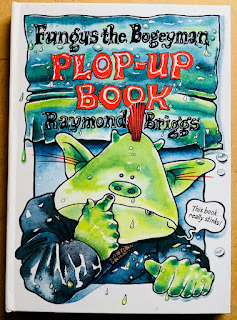
 Here's Fungus about to use the facilities.
Here's Fungus about to use the facilities. Fungus's toilet 'The Leaky' has a sign in it: DO NOT PUT ANYTHING IN HERE UNLESS YOU HAVE EATEN IT FIRST, and it's patented non-flush and guaranteed to rust.
Fungus's toilet 'The Leaky' has a sign in it: DO NOT PUT ANYTHING IN HERE UNLESS YOU HAVE EATEN IT FIRST, and it's patented non-flush and guaranteed to rust.I love thetoilet page, complete with Government Property toilet paper that tells you the addressof the person to complain to about this page (and that there's an entire complaints department dedicated to Fungus the Bogeyman). (For more on the wonderful Raymond Briggs, see Pippa Goodhart's post from last week.)
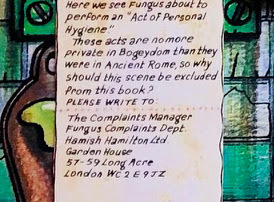
OK, the Pop-up toilet is an obsessionof mine. Here are a couple of pop-up toilets I’ve made.
 From Our Machines are Sick, personal project from long ago
From Our Machines are Sick, personal project from long ago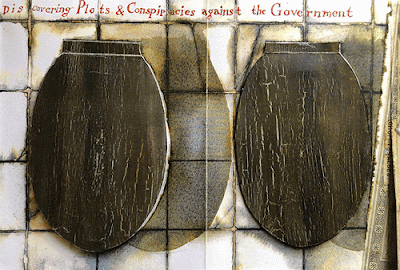 These toilets are for using the contents to discover plots and conspiracies with a bit of stool-reading - from Gulliver's Travels (to Laputa). (personal project from long ago)
These toilets are for using the contents to discover plots and conspiracies with a bit of stool-reading - from Gulliver's Travels (to Laputa). (personal project from long ago)And on, and away from toilets, to the kingof pop-up – Robert Sabuda. My favourite is the Wizard of Oz.

Look at the cityof Oz with its iridescent foil and green glasses to wear.
 The Wizard of Oz by Robert Sabuda
The Wizard of Oz by Robert Sabuda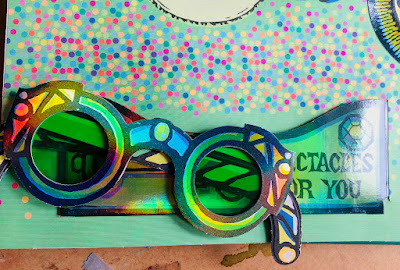
The message in themulticoloured dots is invisible until you put the green glasses on. (In photos you can make it out, but in real life you can't.) There’s also his Alice in Wonderland. Hereis a beautiful V-fold house with a gigantic Alice trapped inside.
 From Alice in Wonderland by Robert Sabuda
From Alice in Wonderland by Robert SabudaThe genius of NickSharrat is in making movable books that play in beautifully simple ways. Here’sthe floating helicopterpus from Octopus Socktopus.
 Octopus Socktopus
Octopus Socktopus
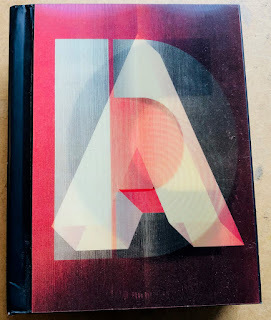 The lenticular cover of ABC3D
The lenticular cover of ABC3DPop-up playtime is not just for children.
ABC3D is a pop-up alphabet of surprises made from purely architectural letters.
Pop-ups can even explainPlate Tectonics. Have a watch here.
In the SensationalBooks Exhibition at the Bodleian Library I came across Creatures of the Deepby Maike Biederstaedt – bringing scientist Ernst Haeckel’s illustrations of underwater flora and fauna to life.

Thereis a Game of thrones pop-up book and a Pop-up Book of Phobias.
 At the dentist in the frankly triggering Pop-Up Book of Phobias
At the dentist in the frankly triggering Pop-Up Book of PhobiasThe Walking DeadPop-up Book – this is an actual horror; zombies attempt to escape the book - lookaway now if you feel fragile.

– and there are even more terrifying pop-ups in this book that I can’t show in afamily-friendly blog like this.
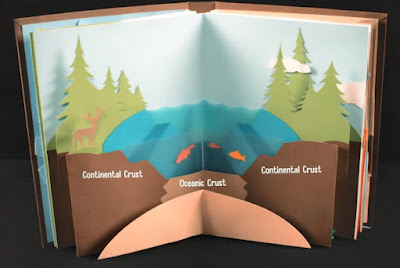
Pop-up involves thereader: the engineer is the puppet-maker, the reader becomes the puppeteer.
But sometimes, lessis more. When my son Herbie was little we acquired the We’re going on a BearHunt pop-up book and you know…the pop-ups felt clunky compared to the pop-up-freeoriginal. A simple flap can often be more effective than a wildly complicated mechanism. The magic of every picture book is to have space for the reader’simagination to get involved.
I’ve only scratchedthe surface of the incredible world of pop-up books in this post. Have you gota favourite? Do let me know!
Bruce Foster, a paper engineer based in the US, commentedabout the process of inventing pop-ups: “The first phase of any project isstrictly playtime,” he said. “I play around a lot, work out these differentmechanisms, putting them all together, experimenting.”
So, to end with, here are some books I’ve found useful for learninghow to make pop-ups, because inventing pop-ups is all about playing with paper.
 Paper Engineering by Mark Hiner.You make your own demonstration models for the mechanisms so it turns into a useful resource for working out what you might need to make - a nice first introduction.
Paper Engineering by Mark Hiner.You make your own demonstration models for the mechanisms so it turns into a useful resource for working out what you might need to make - a nice first introduction. Pop-Up - A Manual by Duncan Birmingham - This is a dense exhaustive guide to just about every paper engineering mechanism. For the die-hard pop-upper.
Pop-Up - A Manual by Duncan Birmingham - This is a dense exhaustive guide to just about every paper engineering mechanism. For the die-hard pop-upper. By the same author - Pop-Up Design and Paper Mechanics is much more user friendly and appealing visually, with a nice set of projects to make at the back.
By the same author - Pop-Up Design and Paper Mechanics is much more user friendly and appealing visually, with a nice set of projects to make at the back. The Elements of Pop-Up by David A. Carter and James Diaz. This is a brilliant resource - it contains little working models for all the mechanisms like a delicious moving menu of pop-up possibilities - being able to see how they move really helps you to choose which mechanism will work for what you want to do.
The Elements of Pop-Up by David A. Carter and James Diaz. This is a brilliant resource - it contains little working models for all the mechanisms like a delicious moving menu of pop-up possibilities - being able to see how they move really helps you to choose which mechanism will work for what you want to do.Still want to see more pop-up books? Watch on Youtube here!
Mini's latest book is The Greatest Show on Earth, published by Puffin.

June 25, 2023
The Raymond Briggs Exhibition, by Pippa Goodhart
I’ve just visited the Raymond Briggs retrospective exhibition currently (until 26th August ’23) running at Cambridge University Library. It’s free entry, and an absolute treat. I was told that I could photograph everything except the Snowman artwork which, in soft crayon, is more vulnerable than most of his work. So I’ll share just some of what I particularly enjoyed there.

Raymond Briggs, who died last year, was the only child of milkman Ernest and housewife Ethel whose lives from courtship to death Raymond recorded in loving and humorous cartoon form. This was their reaction when their grammar school son decided to leave that school at fifteen to study art –
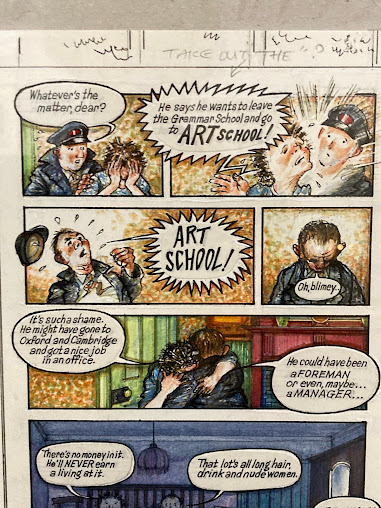
The art school weren’t impressed with his idea of working on cartoons. Yet the cartoon style was to became the basis of his most famous books, from Snowman to Fungus The Bogeyman.
But Raymond Briggs could do classical style as well, and sublimely. Look at this from Gentleman Jim, an exhibit in the gallery where he is a cleaner –
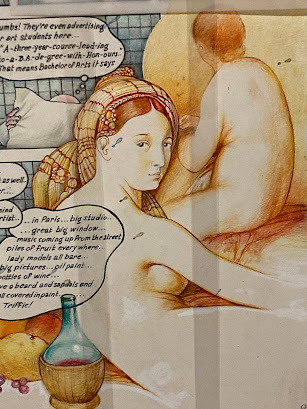
Or this brilliant early line drawing of an ordinary spoon –
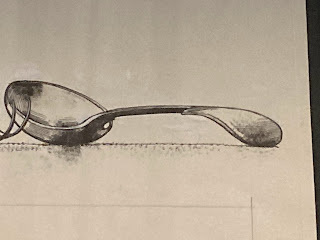
Early illustration work was of the more traditional kind, before he had the self-belief, and/or the belief of publishers, to be more original and bold.
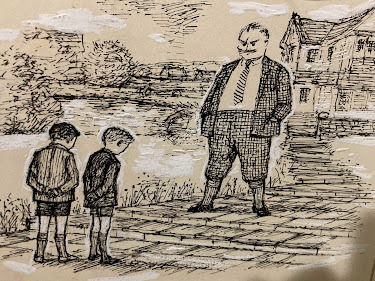
One of the fascinations of the exhibition is that we get to see Raymond Briggs’ working techniques. He tends to record the days, and even hours, spent on artwork in the margin. And he likes to get his pen flowing by squiggling in those margins before setting it to work on the picture! This is from When The Wind Blows –
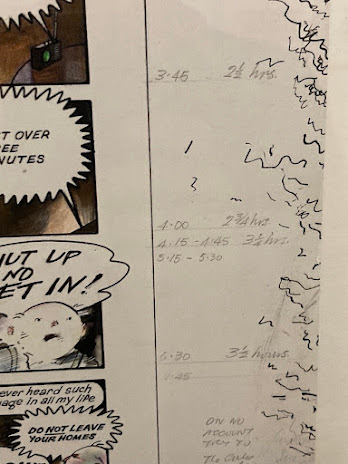
In early work he uses Tipex, seemingly not just to correct but (I’m no artist, so I’m guessing!) also to get some shadowing effect.

And we read notes presumably written by his editor. I liked this one! –
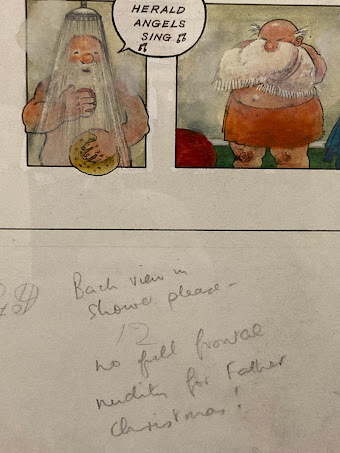
In his work we have a mix of picture books inspired by the children in his life – Ug, Bear, The Puddleman, for example – and the furious angry political books about the pointless destruction of war, nuclear or conventional. Briggs compares Tin-Pot Foreign General Galtieri and Old Iron Woman Margaret Thatcher to Punch and Judy as they played out the Falklands War with the lives of others in 1982. That book is illustrated with huge furious energy and clarity, and with searing brightness. You really need to see them for yourselves because reproductions in books or in photographs just don’t convey the power of their colours as well as their lines.
And there’s so much more. Go and see it if you can! Meanwhile, ‘Goodnight’ from Father Christmas over Buckingham Palace.
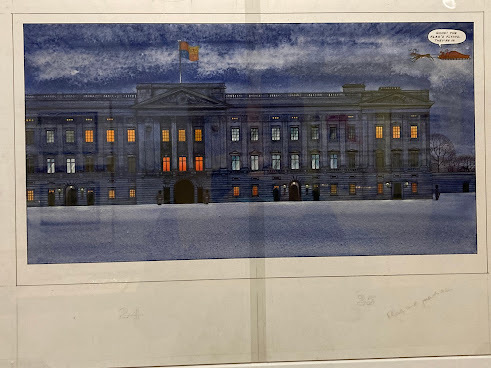
I’m off to read my two year old grandson The Elephant and the Bad Baby … although I’m with Raymond Briggs on questioning why the Baby is ‘bad’ for not saying ‘please’ whilst the Elephant is in no trouble for stealing things!
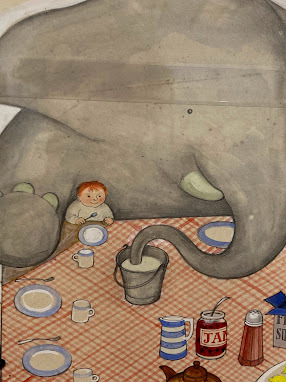
June 16, 2023
Caring fathers and devoted dads in picture books - Garry Parsons
No one is perfect at being a parent and nor would we want to be, but fathers in picture books, sometimes seem to get a raw deal.
Dads are often depicted as caricatures of dads, preoccupied with tasks in the shed, washing the car or tinkering under the bonnet. Sometimes shown as unkempt or dishevelled, they can appear absent minded, aloof or uncaring, preferring to fix things than parent directly. Sometimes they simply don't make an appearance at all.
Equally, at the other end of the spectrum, Dads sometimes appear a stretch beyond the parent, as super humans, taking on over exaggerated super hero personas whilst still maintaining a sense that underneath they are buffoons.
So it’s a relief to see Dads being depicted as fathers who care and are parenting from a place of nurture. Dads who occupy an environment that is in or close to the home, where the child protagonists feel they are in safe hands, despite the challenges they face and the reader does too.
 Don't Let Go! - Jeanne Willis and Tony Ross
Don't Let Go! - Jeanne Willis and Tony RossJust in time for Father's Day, here are few picture books where Dad takes centre stage and gets on with the job of parenting.
These are fathers who feel fully rounded in their parenting, dads who are gentle and willing to listen and who are keen to impart wisdom to help their children grow, without being over the top superhuman, down trodden or saccharine.
Clare Helen Welsh recommended Eve Coy's 'Looking after William' to me. A revealing tale of home-life told from the perspective of the daughter where the roles are reversed and the little girl takes on the task of parenting her dad, William.
The reader is witness to a father who is a fully engaged parent, quietly getting on with all the domestic duties required for looking after a young child and enjoying the playful moments too.
 Looking After William - Eve Coy
Looking After William - Eve Coy Looking After William - Eve Coy
Looking After William - Eve CoyIn Lawrence in the Fall by Matthew Farina and Doug Salt, Lawrence and his Papa go searching in the woods to collect things to show in school. During the story, Papa gently departs his knowledge of the forest and his wisdom of how the world works. In a tense moment when they become separated, Lawrence discovers a forest secret of his own.
This is a tender story of the bond between father and son where the characters express how they feel and deal with subtle life moments. Beautifully illustrated scenes and characters that capture the tenderness and wild elements of the landscape.
 From Lawrence in the Fall by Matthew Farina & Doug Salati
From Lawrence in the Fall by Matthew Farina & Doug SalatiAsk Me by Bernard Weber and illustrated by Suzy Lee is a walk in the country taken by a father and his daughter. The little girl prompts her dad to ask questions so she can express all the things she likes in the world. Dad quietly participates and diligently asks all the questions she wants to answer herself, cleverly printed in different coloured type to distinguish the two voices and wonderfully illustrated.
 Ask Me - Bernard Weber - Illustrated by Suzy Lee
Ask Me - Bernard Weber - Illustrated by Suzy Lee Ask Me - Bernard Weber - Illustrated by Suzy Lee
Ask Me - Bernard Weber - Illustrated by Suzy LeeIn 'Don’t Let Go!' By Jeanne Willis, illustrated by Tony Ross, a little girl wants to visit her daddy but to do that she needs his help to learn to ride her bike. This is a story of an attentive, patient dad, teaching his daughter skills to prepare her for her life ahead through teaching her to ride her bike. As she becomes more confident at riding, it becomes apparent that it is dad who needs some comforting and it is she who is teaching him. Prepare to be moved by this affectionate father and daughter relationship.
 Don’t Let Go! By Jeanne Willis, illustrated by Tony Ross.
Don’t Let Go! By Jeanne Willis, illustrated by Tony Ross.What We’ll Build by Oliver Jeffers is a story of a father and daughter setting out plans for their life together, building life skills, imparting knowledge to create memories and a home to keep them safe. A moving story of love and protection.
 What We'll Build - Oliver Jeffers
What We'll Build - Oliver JeffersTwo picture books to make you laugh - Pete’s A Pizza by William Steig and Knuffle Bunny, a cautionary tale by Mo Willems, both firm favourites in our house and consistently funny.
It's raining outside so Pete can't go outside to play. Pete's attentive dad decides to make him into a pizza instead and bake him on the sofa. A funny and warm story around the kindness of a tuned-in dad with paired-down but spot-on illustrations.
 Pete's a Pizza - William Steig
Pete's a Pizza - William SteigDad is competently in charge in Knuffle Bunny, doing some chores and caring for his daughter Trixie at the same time. He's doing a fine job of it until it all goes wrong at the laundromat. No superhero strategies here just human imperfections.
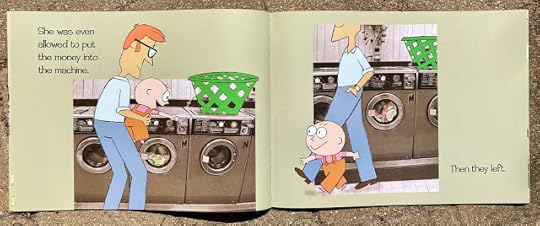 Knuffle Bunny - Mo Willems
Knuffle Bunny - Mo WillemsSo here's to celebrating the fully formed Dad in picture books, all year round!
Happy Father's Day!
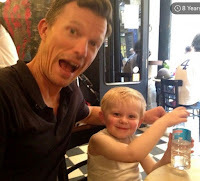
Garry Parsons is an award winning illustrator of children’s books and father to two boys and is the illustrator of My Daddies! By Gareth Peter, a story celebrating fatherhood through adoption.
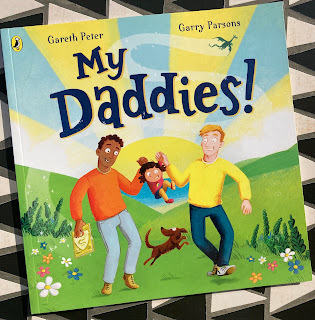
@icandrawdinos www.garryparsons.co.uk
***
June 11, 2023
Writing pays badly. Does it matter? Moira Butterfield
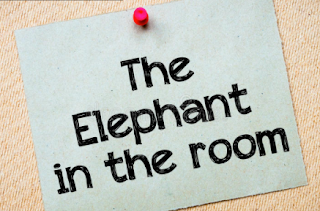 Money
Money
Yet I am part of an increasingly rare full-time group. From 2022 figures published by the ALCS we know that overall author earnings are in steep decline, and now just 19% of writers are full-time. The average earnings of a fulltime author dropped by 60% in 16 years and is now £7000, under the minimum wage. This report was published in a year when UK publishing houses posted record overall profits. The report makes sorry reading (for more, there's a link to the survey at the bottom of this blog).
I look at the prospects for young people starting out now and, given the cost of living and the cost of a place to live, I think that the idea of being a full-time author is pretty much going extinct. Starting out, I could never make that choice now. It seems you can only afford to spend time writing if you have another main job, a pension from a previous career or a high-earning partner who will support you.
Meanwhile publishers say they want a more diverse writing world, with people from all sectors of life…Well there’s a massive elephant that’s filling the whole of the room here and it’s carrying a sign in its trunk – WRITING DOESN’T PAY ENOUGH FOR THAT TO HAPPEN. The money is not being shared round enough for anybody who is not well-off to consider it a main career option.
 The elephant that lives in big profitable publishing companies.
The elephant that lives in big profitable publishing companies.
In addition to writing, publishers now expect us to pay for our own book launches and book publicity efforts. For those who aren’t well-off it doesn’t seem possible. School visits might provide a main income for some but most people with young kids or another job simply couldn’t travel round the country, let alone wait for months for appearance payments.
Recently we have had large conglomerate publishers sending round well-meaning diversity surveys to fill in, but no amount of bureaucratic box-ticking is going to help with this.
Publishers need to acknowledge the elephant that stops so many people coming through their doors. It’s money.
Share the profits out more fairly with creatives or writing becomes an exclusive hobby-world for the elite.
Moira Butterfield has written many internationally-sold books for children and has been a full-time writer for over two decades. Her latest publications are The Secret Life of Oceans (Bloomsbury), Look What I Found On the Farm (Nosy Crow) and Does a Monkey Get Grumpy? (Bloomsbury)
Moira Butterfield
moira@moiraworld.co.uk
twitter @moiraworld
instagram @moirabutterfieldauthor
The link to the author earnings survey referenced above:
https://www.alcs.co.uk/news/why-writers-are-at-a-loss-for-words
June 4, 2023
EVERYTHING YOU NEED TO KNOW ABOUT SCHOOL VISITS by Clare Helen Welsh
In a bookshop last week, I bumped into two sisters.They’d recognised me after I’d visited their school during World Book Week. Itwas such a surprise since we were miles from home and all on holiday! There wasmuch excitement from both parties, confirming to me the importance of school visits- getting into schools to reach and interact with readers.

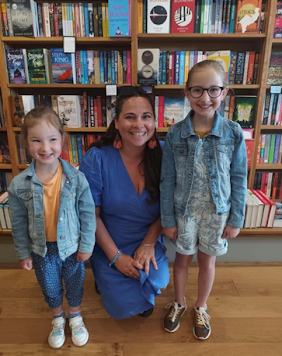
A CHANCE MEETING IN PADSTOW BOOKSELLER
But did you know, that in 2023 only onein five children said an author had visited their school, either online or inperson?
A Twitter thread from the National Literacy Trust and this chance encounter prompted me to write about schoolvisits for today’s Picture Book Den post. The National Literacy Trust researchedthe impact of author visits in schools (both online and in person). They foundthat children who attended author visits were more likely to enjoy reading andwriting in their free time. I’moften asked about school visits - what should they be like, how to prepare forthem, how to get them and do you have to be published to offer them? So, I thought this might be agood opportunity to champion school visits, and share a bit about how they can look.
Youcan read the full National Literacy Trust report here: Authorvisits in schools, and children and young people’s reading and writingengagement in 2023 | National Literacy Trust
WHATIS A SCHOOL VISIT?
School visits can in person or online.They can be with a whole school, with a key stage, with groups of classes or asingle class… or a combination of all of these! The school that has booked thevisit might have a purpose for your appearance in mind – to encourage reading forpleasure or to link with a curriculum topic - or your visit might be to celebrate thelaunch of your book. They can vary enormously, but this is good news! It meansthere is no set way they should be. If you play an instrument, why not makethis part of your session? You might be confident drawing, at home with apuppet or prefer talking with slides… play to your strengths and what you feelcomfortable with. It’s important for children to see there are lots ofdifferent kinds of authors, just like there are different kinds of people. And it's important that your school visit reflects you.
Whatever the theme of the day, I usually begin withsome fun facts and photos about me and my books on a screen. Consider includingthings like; previous jobs, childhood photos, your writing inspiration, yourwriting space… it might feel boring to you, but it’ll be fun and different forthem. If there’s no tech available, I do the same with props to keep thechildren’s attention.
In workshops, I always try to plan an activity thatsees the children take away something physical, and something that can be expandedon in class should the teachers wish to do so. I also make a big effort toensure the sessions are interactive and engaging, building in a strong hook sothat children can’t wait to start and will remember the day for a long timeafterwards. I tend to structure workshop sessions like this:
– Warmer
– Hook and shared activity
– Independent activity
– Share and tell
– Q&A/ Quiz


Here are some examples of the activities I’ve led inthe past:
- making sunny-side specs
- making lemur tail twisters (think tongue twisterswritten on tails!)
- biscuit tin crime scene
- design and make a biscuit rocket
- create your own story character
- 'creative compost' idea gathering workshop
- create your own graphic novel
- puppet making
Whatever you decide, it always nice to end aworkshop with a show and tell session. It’s unlikely you’ll have had chance tospeak to everyone individually, so asking them to talk with the person next tothem, and then a few feeding back to the whole group, gets around this problemnicely. I use my story TV and microphone, for this! It’s a bit of encouragementto share ideas, plus, who doesn’t want to be on TV?!
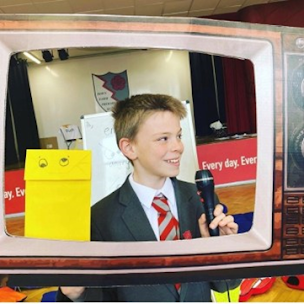
THE END OF A SCHOOL VISIT WORSHOP -
'SHOW AND TELL'
HOWDO YOU PREPARE FOR A SCHOOL VISIT?
It takes a lot of planning to ensure a school visit runs smoothly. This could include all or some of the following;
– communication with the school about logistics,payment and terms
– organising a book sale and liaising with a local bookshop
– making posters to advertise the event
– booking transport
– planning and resourcing
I also try to build children’s excitement andanticipation, by sending schools activities and material in advance. You mightbe the last author the children meet for some time – you might be the first oronly author they meet! Something that works nicely is sending ahead a writingcompetition to be judged on the day. You might be able to think of somethingthat links with your book or theme for the day.
I try to arrive around an hour before the eventstarts to set up and familiarise myself with my home for the day. It’simportant for me to leave plenty of time because I often bring lots ofresources that need unloading and because schools are busy places – yousometimes don’t know the finer details of where you’ll be based until youarrive and even then, plans can change. Also, if you’re going somewhere youhaven’t been before, leave in some buffer time for traffic, delays, parking (orthe lack of it) and getting lost! Better to have time to spare than bepanicked, I think.
Giving children the opportunity to buy books can belovely for all concerned. Some schools request a book signing, at the start or endof the day. If there’s a local bookshop to organise this, that’s great. If not,I set it up with a pre-order system so that I can source books from a sellerlocally to me. If your event is online, you might be able to liaise witha local bookseller and send signed/ dedicated bookplates.
After the event, I make sure to thank the staff fortheir help and hospitality, both in person and email. I usually follow up witha blog post and photo share, if I have been given to permission to take photos.This is something to check in advance.
In case you’re interested, a few yearsago I wrote a post forMy Book Corner with even more detail about my school visits. You can read thatpost here: AGuide to Author Visits by Clare Helen Welsh - My Book Corner]
HOWDO YOU GET SCHOOL VISITS?
It’s a great idea to have your contact andevent details on a website or on social media, showcasing what you can offer, including a price list. If you need advice on pricing, have alook at the Society of Author guidelines: Feesfor author school visits - The Society of Authors
Think about what makes you and your visits special. I travel by authormobile, so I try to share photos of this because it’s different. Author, Cara Matheson, takes her cockapoo, Scout!
As well as photos, you could also sharetestimonials from your events to help get the word out. If you’re a published authoror illustrator looking to do more events, you could also try contactingorganisations such as AuthorsAloud, AuthorsAbroad, ContactAn Author, ReadingRocks, NationalLiteracy Trust .

BLUNDELLS PREP SCHOOL
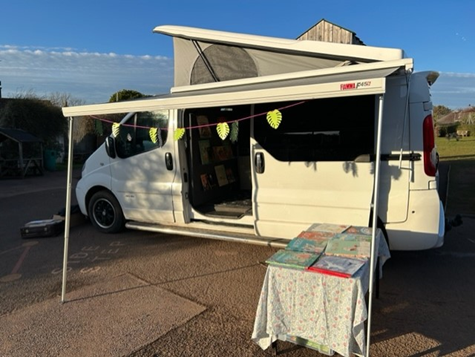
THE 'AUTHORMOBILE!'

AUTHOR, CARA MATHESON, AT A SCHOOL VISIT

'SCOUT' THE COCKAPOO!
WHOCAN DO SCHOOL VISITS?
I am keen to dispel the myth that onlypublished writers and illustrators can do school visits. I know firsthand howinspiring it can be for children to see the journey as opposed to just thefinished product. Any creative with a passion for what they do should feel ableto share that if they want to.
Sarah Dollar is a writer and poet looking for representation and a home forher picture book manuscripts. I asked her to share her school visit experiences:
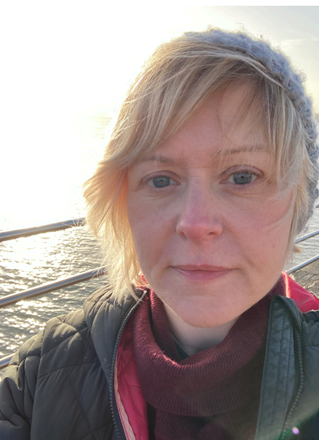
AUTHOR, SARAH DOLLAR.
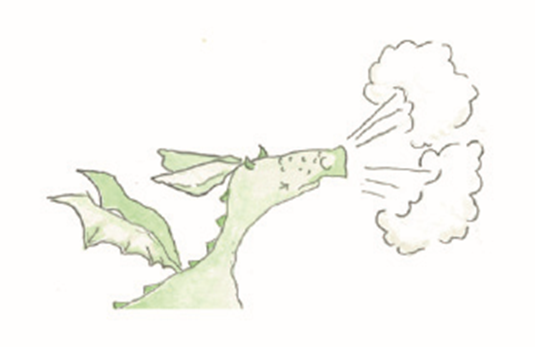 SARAH'S ILLUSTRATION OF 'MILDRED.'
SARAH'S ILLUSTRATION OF 'MILDRED.'“Mildred’ is an (as yet)unpublished character I created with my son, Hugo, in mind. He has severe foodallergies and Mildred suffers from hayfever. My thinking was that it would openthe door to meaningful conversations about allergies that might lead to moreunderstanding amongst his peers.
When Allergy Awareness Week cameround, I saw an opportunity to sidestep the gate-keepers and seek my ownreward. I’m not an overly confident person, but I suffer flashes of over-the-topenthusiasm. I collared his teacher, “I don’t know if you have anything plannedfor Allergy Awareness Week yet, but I’d be happy to read a story to the kids inHugo’ s class? ”. To mysurprise, and vague horror, she jumped on it! Before I’d left the playgroundshe had given me a day, a time and four classes to present to! Gulp!
I watched many Youtube videos,such as Joseph Coelho’s Poetry Prompts. I sought advice: wear something bright,take props, be prepared to be silly. Ipractised taking questions (from anyone willing to play along) and read thestory out loud - a LOT! I was nervous and met with a whispered chorus of ‘It’s Hugo’ s mum! ’, but the teacher introduced me as a writer. The children wereexcited.
My nerves settled quickly. I got afew children to help make Mildred’s soup concoction in a giant pan withimaginary ingredients. They laughed in all the right places. They engaged!Having repeated the session with another three class groups, I left the school- brimming. I floated out to the car park and stashed my props.
I did sessions for a nursery downthe road and when poetry day rolled around I was approached by another localschool. The kids enjoyed it. And I loved it. I may only have a few school visits under my belt, but the reactionfrom the children I've met has left me in no doubt - this is where my futurelies.”
What an inspiration, Sarah is! I hopeher experiences inspire you and give you permission to contact a school or bookshop or library for storytelling, if you wish. It doesn’t have to be pre-published or even published story. Why not take along a selection of your favourite books toshare?
If you’d like to find out moreabout Sarah and her visits, she’ll be featured in Write Mentor’s Final Wordnewsletter very soon. You can sign up for that here: Home - WriteMentor - for all writers ofchildren's fiction (write-mentor.com)
WHY DO SCHOOLVISITS?
If visiting a school has already been on your radar, I reallyhope this article and the National Literary Trust research have inspired youto take the plunge. In case you’re still unsure, have a read of these testimonials.School visits really do make a difference!
“Theworkshop was amazing! The children were engaged from start to finish. Such agreat way to get such young children to believe in themselves as writers! Thechildren haven’t stopped talking about where they are going to travel in theirrocket!”
“Theboys in Year 6 were so very proud of their writing and shared it first thingwith their teacher the following day who was blown away. Thank you again,it was a wonderful afternoon.”
“Allchildren were totally engaged and enthralled throughout the workshop. Clare wasfantastic with the children, bringing plenty of props to excite and provokecreativity from the group. The children were well guided and fully involvedthroughout the session.”
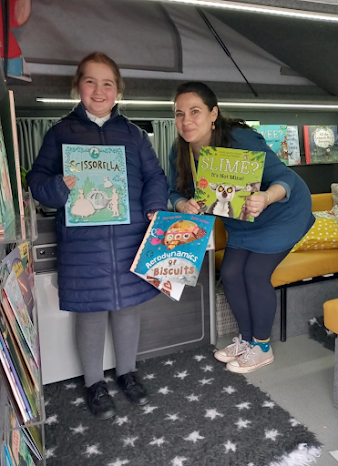
SARAH DOLLAR
Sarahwas born in London and grew up in Devon, where she lives now with her partnerand their three (very) energetic children. She writes short stories, picturebooks, chapter books, poems and even cryptic crossword clues! She waslonglisted for the 2021 Stratford Salariya Picture Book Prize and was includedin the finalists' showcase for Mindy Weiss’s Picture Book Party. Both pieceshave since been published. You will find her writing in places such as TheDirigible Balloon and Parakeet and Paperbound Magazine. She has alsocontributed to the spoken word event Book Jive Live. Find her on Twitter@SarahLCDollar.
CLARE HELEN WELSH
Clare Helen Welsh is a children's writer from Devon. Shewrites fiction and non-fiction picture book texts - sometimes funny,sometimes lyrical and everything in between! Her latest picture book is called 'Sunny Side Up,' illustrated by Ana Sandfelippo and published by Little Tiger Press. You can find out more about her at her website www.clarehelenwelsh.com or on Twitter @ClareHelenWelsh . Clare isrepresented by Alice Williams at Alice Williams Literary.



